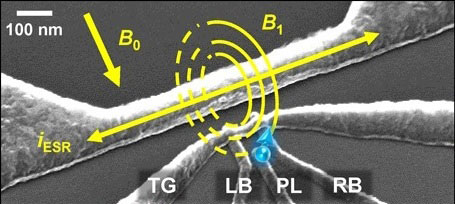| A research team, including members from the London Centre for Nanotechnology (LCN), has created the first working quantum bit based on the nuclear spin of a single phosphorus atom in silicon, opening the door for dramatically improved data processing in ultra-powerful quantum computers of the future. | |
| A landmark paper published today in the journal Nature ("High-fidelity readout and control of a nuclear spin qubit in silicon"), describes how to write and read quantum information with record-setting accuracy using the nuclear spin, or magnetic orientation, of a phosphorus atom in a silicon transistor – similar to silicon chips used in modern electronics. | |
The nucleus of a phosphorus atom is a very, very weak magnet, and can be imagined as a compass needle that can point north or south. These north or south positions are equivalent to the zero and one of binary code, which governs classical computing. In this experiment, the researchers controlled the direction of the nucleus, in effect “writing” an arbitrary value onto its spin, and were then able to “read” the value out. They observed quantum oscillations of the spin between north and south, and all the quantum superpositions of those two directions – where the spin exists in both states simultaneously. Scanning electron micrograph of the active area of the qubit device, showing an implanted donor (donor as blue arrow), the single electron transistor (SET) and the short-circuit termination of the microwave line. The device is mounted in a dilution refrigerator with an electron temperature of,300 mK, and is subjected to static magnetic fields B0 between 1.0T and 1.8 T. B0 is oriented perpendicular to the short-circuit termination of the microwave line (solid orange single-ended arrow), which carries a current (solid double-ended arrow) and produces an oscillating magnetic field B1 (represented by the solid and dashed circles) perpendicular to the surface of the device. TG, top gate; PL, plunger gate; LB, left barrier; RB, right barrier. Fuente: Nanowerk (2013). Quantum information: Computing with a single nuclear spin in silicon. Recuperado el 6 de mayo de 2013, de http://www.nanowerk.com/news2/newsid=30267.php |
lunes, 6 de mayo de 2013
Quantum information: Computing with a single nuclear spin in silicon.
Suscribirse a:
Enviar comentarios (Atom)
No hay comentarios:
Publicar un comentario